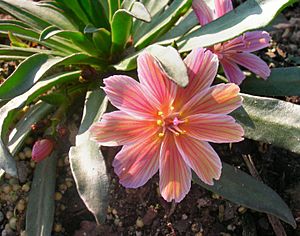Long-petalled lewisia facts for kids
Quick facts for kids Long-petalled lewisia |
|
|---|---|
 |
|
| Lewisia longipetala 'Little Plum' | |
| Scientific classification | |
| Genus: |
Lewisia
|
| Species: |
longipetala
|
The Lewisia longipetala is a special and rare flowering plant. People often call it the long-petalled lewisia or Truckee lewisia. It's part of a plant family called Montiaceae.
This plant is found only in one place: the Sierra Nevada mountains in California. There are fewer than 20 known spots where it grows naturally, mostly near Lake Tahoe.
Where It Lives
The long-petalled lewisia loves high, cold mountain areas. It grows in places that are moist and rocky, like slopes covered in loose rocks called talus. These spots often have patches of snow that stay all year long.
Most of these plants grow on slopes that face north. This means they get less direct sunlight. They also prefer areas with not many other plants around. The plant really thrives in the snow. It grows bigger and thicker in places that get a lot of snow. If it's too far from snow, it can easily get thirsty and struggle to grow.
What It Looks Like
This plant is a perennial herb. This means it's a plant that lives for many years, not just one season. It grows from a thin main root, called a taproot, and a short stem part.
At the bottom, it has a circle of many thin but fleshy leaves. This circle is called a basal rosette. Each leaf is about 3 to 6 centimeters long. The plant also produces several flowers on short stalks. This group of flowers is called an inflorescence.
Each flower has about 8 petals. These petals are usually pinkish and are about 1 to 2 centimeters long. The tips of the petals have tiny sticky dots, called resin glands. You can also find similar dots on the edges of the small leaf-like parts near the flower, called bracts, and on its two small sepals.
Growing in Gardens
Even though it's rare in the wild, some types of Lewisia longipetala are popular garden plants. These are often hybrids, which means they are mixes created by crossing this plant with other plants. For example, some popular garden varieties are crosses between Lewisia longipetala and Lewisia cotyledon. They grow well in gardens that have the right climate.

